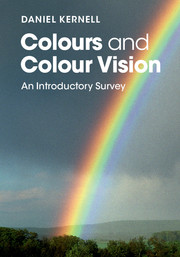Book contents
- Frontmatter
- Dedication
- Contents
- List of plates
- List of figures
- List of tables
- Preface
- 1 Colour vision in everyday life
- 2 The signals of colours: light and wavelengths
- 3 Colours and viewing conditions: not only local wavelengths
- 4 Our biological hardware: eye and brain
- 5 Eyes with unconventional properties: the ‘red-green blinds’
- 6 Other kinds of unconventional colour vision
- 7 Colour vision in different species of animals
- Appendices
- Notes
- References
- Index
- Plate section
6 - Other kinds of unconventional colour vision
Published online by Cambridge University Press: 05 March 2016
- Frontmatter
- Dedication
- Contents
- List of plates
- List of figures
- List of tables
- Preface
- 1 Colour vision in everyday life
- 2 The signals of colours: light and wavelengths
- 3 Colours and viewing conditions: not only local wavelengths
- 4 Our biological hardware: eye and brain
- 5 Eyes with unconventional properties: the ‘red-green blinds’
- 6 Other kinds of unconventional colour vision
- 7 Colour vision in different species of animals
- Appendices
- Notes
- References
- Index
- Plate section
Summary
Besides the commonly encountered inborn red-green blindness, there are several other categories of deviating colour vision, as will be described in this chapter.
Inherited blue-green blindness (tritanopia)
This is a relatively uncommon variety of colour vision with deviations concerning the ‘third’ kind of cones, the S cones (previously called ‘blue’ cones) (Table 6.1). People with an inborn blue-green blindness (tritanopia) may completely lack the function of these receptor cells. In some less extreme forms, the lack of S-cone function is evident but not complete. In addition, it has often been assumed that people might exist who have normal numbers of S cones although their colour vision is changed due to deviant S-cone functions, e.g. as caused by inborn changes in the properties of the S-cone visual pigment. However, it is uncertain whether such people and the corresponding colour vision category of tritanomaly actually exist. The inheritance of inborn tritanopia is not sex linked; the gene for the S-cone opsin is localized to chromosome 7.
In CIE chromaticity charts, the confusion lines for tritanopes are radiating out from the lower-left blue/violet corner (Figure 5.3c); colours lying along one of these lines tend to be confused with each other. This kind of deviation has often been referred to as ‘blue-yellow blindness’. However, as the confusion lines demonstrate, the uncertainties tend to concern blue versus green more often than blue/violet versus yellow; hence, this constitution should be called ‘blue-green blindness’. Tritanopes confuse saturated colours of the wavelengths 400–510 nm, and they have a neutral point at yellow (~569 nm) and another one close to the violet shortwave end of the spectrum (<400 nm). People with this kind of deviation might have some use for an optical blue filter, as an aid for discovering differences between blues and shortwave greens. However, as was mentioned above, practical problems involving colour-coded signals are less severe for the blue-green blinds than for the red-green deficient members of the population.
Inherited total colour blindness
Total colour blindness (achromatopsia) is very uncommon; such people have no perception of chromatic colour and they see the world in terms of lightness variations only, in black and white and shades of grey, like in a black-and-white movie. Interestingly, even the concept of ‘grey’ might be difficult to grasp for an achromatic person.
- Type
- Chapter
- Information
- Colours and Colour VisionAn Introductory Survey, pp. 167 - 177Publisher: Cambridge University PressPrint publication year: 2016



